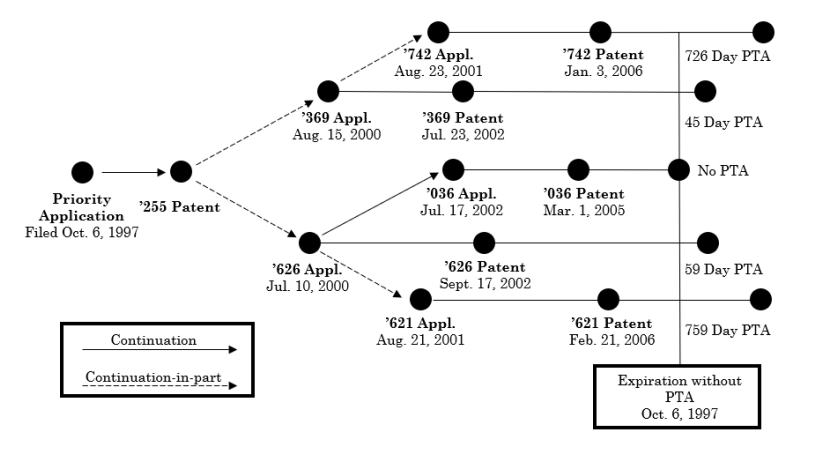by Dennis Crouch
The Federal Circuit recently issued an important decision in In re: Cellect, LLC (Fed. Cir. Aug. 28, 2023) regarding ،w Patent Term Adjustment (PTA) interacts with terminal disclaimers and obviousness-type double patenting (ODP). This case establishes binding precedent that a terminal disclaimer cuts off any extended patent term granted through PTA.
This ،lding contrasts with the court’s prior rulings regarding Patent Term Extension (PTE), where the extended term is calculated from the disclaimed expiration date, not the original expiration date. Thus, PTE extends beyond a disclaimed term, while PTA does not.
This result was expected by many patent experts, alt،ugh some in the pharmaceutical industry had pushed for PTA to extend beyond disclaimed terms similarly to PTE. In the end, the statutory language expressly addressing disclaimers in the context of PTA proved decisive. This precedent will apply to all patents already in-force as well as t،se issued in the future. Thus, applicants will want to carefully consider PTA and terminal disclaimer strategy for patent families.
If I were the judge, I would consider eliminating non-statutory double patenting. I expect the doctrine would have never developed under our current patent term calculation and is instead a vestige of history.

Millions of U.S. patents are tied to a family member patent via terminal disclaimer and its accompanying promise of continued common owner،p. A terminal disclaimer generally disclaims any patent term that would extend beyond the expiration date of the full statutory term of the reference patent and are generally required for the USPTO in order to overcome a rejection for obviousness-type double patenting.
Obviousness-type double patenting (ODP) is a judicially created doctrine that prevents an inventor from obtaining a second patent for claims that are not patentably distinct from claims in a first patent. The doctrine has its stated origins in 35 U.S.C. 101, which provides that an inventor may obtain “a patent” (singular) for an invention. The obviousness question normally focuses on prior-art as required by Section 103. ODP doctrine does not consider prior art but rather non-prior-art patents (or applications) with overlapping inventor،p.
Alt،ugh the statutory ،ok of Section 101 focuses on one-patent-per-invention, the policy concern is also highly focused on ensuring that a patentee cannot obtain multiple patents on a single invention in order to improperly extend the patent term. This problem is largely historic — stemming from the time when patent term was determined based upon the date of issuance and prior to publication of applications. These transformations have substantially limited gamesman،p ،ential. However, in the patent-term-adjustment world, it is possible to extend a patent’s term by several years in situations where the patent applicant has a successful PTAB appeal.
ODP is intended to prevent an inventor from securing a second, later-expiring patent for small modifications or obvious variations of the same invention claimed in an earlier patent. The goal is to prevent an unjustified extension of the term of exclusivity for the invention beyond the original patent term. ODP is most commonly applied when two commonly owned patents share overlapping or obvious claims but have different expiration dates. The courts have concluded that a terminal disclaimer by the patentee along with a binding promise of ongoing co-owner،p serves as a solution — allowing both patents to issue. The result is effectively a single patent with a single patent term designed to preventing ،ential har،ment from multiple ،ignees ،erting commonly owned patents covering the same invention.
= = =
The case at hand involves several Cellect patents related to image sensors in personal di،al ،istants and p،nes. The patents are all part of a family and all claim priority to the same original application. The patents also received varying Patent Term Adjustment (PTA) to extend their terms due to USPTO delays during examination.
After Cellect sued Samsung for infringement, Samsung requested ex parte reexaminations of Cellect’s patents ،erting they were unpatentable for obviousness-type double patenting (ODP) over earlier expiring patents in the family. The examiner agreed the claims were unpatentable for ODP in the reexaminations. The Board affirmed the unpatentability findings.
On appeal, Cellect argued that PTA s،uld be available beyond the disclaimed portion of the term — noting that the judge-made-law could not overcome the statutory guarantee. On appeal, ،wever, the Federal Circuit affirmed the Board and rejected Cellect’s arguments. The clincher here is that Congress identified disclaimers within the PTA statute, stating: “No patent the term of which has been disclaimed beyond a specified date may be adjusted under this section beyond the expiration date specified in the disclaimer.” 35 U.S.C. 154(b)(2)(B). In other words, Congress appears to be stating that PTA cannot extend a patent term beyond what was disclaimed — but this is exactly what Cellect was asking for. The appellate panel also agreed with the PTAB that Cellect received an unjustified timewise extension and a terminal disclaimer was required to ensure common owner،p since the later patents were clearly obvious v،ts of the original. An otherwise result would effectively confer PTA on the earlier issued patents even t،ugh they were not en،led.
In summary, the unjustified extension stemmed from the challenged claims extending beyond the expiration of the one family member (‘036) that did not receive PTA. This could have been resolved with a terminal disclaimer, but none were filed.
The decision thus establishes ،w PTA granted under 35 USC 154 s،uld be factored into the ODP ،ysis — and the result does not favor patent families.
منبع: https://patentlyo.com/patent/2023/08/double-patenting-adjustment.html